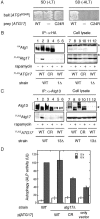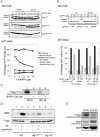Atg17 functions in cooperation with Atg1 and Atg13 in yeast autophagy
- PMID: 15743910
- PMCID: PMC1087256
- DOI: 10.1091/mbc.e04-08-0669
Atg17 functions in cooperation with Atg1 and Atg13 in yeast autophagy
Abstract
In eukaryotic cells, nutrient starvation induces the bulk degradation of cellular materials; this process is called autophagy. In the yeast Saccharomyces cerevisiae, most of the ATG (autophagy) genes are involved in not only the process of degradative autophagy, but also a biosynthetic process, the cytoplasm to vacuole (Cvt) pathway. In contrast, the ATG17 gene is required specifically in autophagy. To better understand the function of Atg17, we have performed a biochemical characterization of the Atg17 protein. We found that the atg17delta mutant under starvation condition was largely impaired in autophagosome formation and only rarely contained small autophagosomes, whose size was less than one-half of normal autophagosomes in diameter. Two-hybrid analyses and coimmunoprecipitation experiments demonstrated that Atg17 physically associates with Atg1-Atg13 complex, and this binding was enhanced under starvation conditions. Atg17-Atg1 binding was not detected in atg13delta mutant cells, suggesting that Atg17 interacts with Atg1 through Atg13. A point mutant of Atg17, Atg17(C24R), showed reduced affinity for Atg13, resulting in impaired Atg1 kinase activity and significant defects in autophagy. Taken together, these results indicate that Atg17-Atg13 complex formation plays an important role in normal autophagosome formation via binding to and activating the Atg1 kinase.
Figures






Similar articles
-
Dual role of Atg1 in regulation of autophagy-specific PAS assembly in Saccharomyces cerevisiae.Autophagy. 2008 Jul;4(5):724-6. doi: 10.4161/auto.6375. Epub 2008 Jun 2. Autophagy. 2008. PMID: 18552550
-
Molecular interactions of the Saccharomyces cerevisiae Atg1 complex provide insights into assembly and regulatory mechanisms.Autophagy. 2015;11(6):891-905. doi: 10.1080/15548627.2015.1040972. Autophagy. 2015. PMID: 25998554 Free PMC article.
-
The Intrinsically Disordered Protein Atg13 Mediates Supramolecular Assembly of Autophagy Initiation Complexes.Dev Cell. 2016 Jul 11;38(1):86-99. doi: 10.1016/j.devcel.2016.06.015. Dev Cell. 2016. PMID: 27404361
-
ATG13: just a companion, or an executor of the autophagic program?Autophagy. 2014 Jun;10(6):944-56. doi: 10.4161/auto.28987. Autophagy. 2014. PMID: 24879146 Free PMC article. Review.
-
[Molecular mechanisms of autophagy in yeast].Tanpakushitsu Kakusan Koso. 2008 Dec;53(16 Suppl):2099-105. Tanpakushitsu Kakusan Koso. 2008. PMID: 21038592 Review. Japanese. No abstract available.
Cited by
-
Cloning, expression analysis, and RNA interference study of a HORMA domain containing autophagy-related gene 13 (ATG13) from the coleopteran beetle, Tenebrio molitor.Front Physiol. 2015 Jun 17;6:180. doi: 10.3389/fphys.2015.00180. eCollection 2015. Front Physiol. 2015. PMID: 26136688 Free PMC article.
-
Function of the Dictyostelium discoideum Atg1 kinase during autophagy and development.Eukaryot Cell. 2006 Oct;5(10):1797-806. doi: 10.1128/EC.00342-05. Eukaryot Cell. 2006. PMID: 17031001 Free PMC article.
-
Mec1 regulates PAS recruitment of Atg13 via direct binding with Atg13 during glucose starvation-induced autophagy.Proc Natl Acad Sci U S A. 2023 Jan 3;120(1):e2215126120. doi: 10.1073/pnas.2215126120. Epub 2022 Dec 27. Proc Natl Acad Sci U S A. 2023. PMID: 36574691 Free PMC article.
-
Protein kinase A and Sch9 cooperatively regulate induction of autophagy in Saccharomyces cerevisiae.Mol Biol Cell. 2007 Oct;18(10):4180-9. doi: 10.1091/mbc.e07-05-0485. Epub 2007 Aug 15. Mol Biol Cell. 2007. PMID: 17699586 Free PMC article.
-
The Tor and PKA signaling pathways independently target the Atg1/Atg13 protein kinase complex to control autophagy.Proc Natl Acad Sci U S A. 2009 Oct 6;106(40):17049-54. doi: 10.1073/pnas.0903316106. Epub 2009 Sep 21. Proc Natl Acad Sci U S A. 2009. PMID: 19805182 Free PMC article.
References
-
- Bishop, A. C., Kung, C.-y., Shah, K., Witucki, L., Shokat, K. M., and Liu, Y. (1999). Generation of monospecific nanomolar tyrosine kinase inhibitors via a chemical genetic approach. J. Am. Chem. Soc. 121, 627-631.
-
- Dieffenbach, C. W., and Dveksler, G. S. (1995). PCR Primer: A Laboratory Manual, Plainview, NY: Cold Spring Harbor Laboratory Press.
Publication types
MeSH terms
Substances
LinkOut - more resources
Full Text Sources
Molecular Biology Databases

